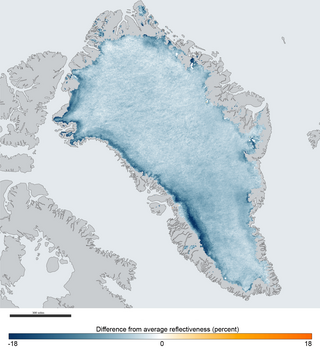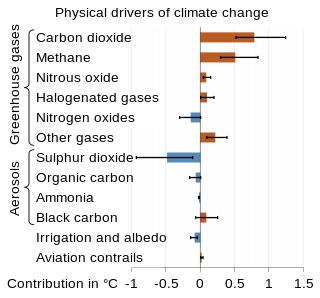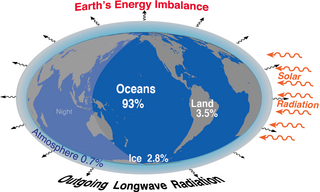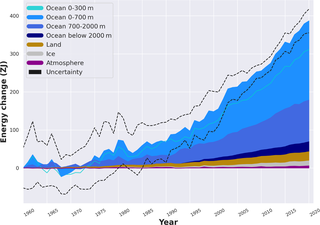
Albedo is the fraction of sunlight that is diffusely reflected by a body. It is measured on a scale from 0 to 1. Surface albedo is defined as the ratio of radiosity Je to the irradiance Ee received by a surface. The proportion reflected is not only determined by properties of the surface itself, but also by the spectral and angular distribution of solar radiation reaching the Earth's surface. These factors vary with atmospheric composition, geographic location, and time.

The scientific community has been investigating the causes of climate change for decades. After thousands of studies, it came to a consensus, where it is "unequivocal that human influence has warmed the atmosphere, ocean and land since pre-industrial times." This consensus is supported by around 200 scientific organizations worldwide, The dominant role in this climate change has been played by the direct emissions of carbon dioxide from the burning of fossil fuels. Indirect CO2 emissions from land use change, and the emissions of methane, nitrous oxide and other greenhouse gases play major supporting roles.

The greenhouse effect occurs when greenhouse gases in a planet's atmosphere insulate the planet from losing heat to space, raising its surface temperature. Surface heating can happen from an internal heat source as in the case of Jupiter, or from its host star as in the case of the Earth. In the case of Earth, the Sun emits shortwave radiation (sunlight) that passes through greenhouse gases to heat the Earth's surface. In response, the Earth's surface emits longwave radiation that is mostly absorbed by greenhouse gases. That absorption of thermal radiation reduces radiative heat loss and reduces the rate at which the Earth can cool off in response to being warmed by the Sun. Adding to greenhouse gases further reduces the rate a planet emits radiation to space, raising its average surface temperature.

Climate variability includes all the variations in the climate that last longer than individual weather events, whereas the term climate change only refers to those variations that persist for a longer period of time, typically decades or more. Climate change may refer to any time in Earth's history, but the term is now commonly used to describe contemporary climate change, often popularly referred to as global warming. Since the Industrial Revolution, the climate has increasingly been affected by human activities.

Numerical climate models are mathematical models that can simulate the interactions of important drivers of climate. These drivers are the atmosphere, oceans, land surface and ice. Scientists use climate models to study the dynamics of the climate system and to make projections of future climate and of climate change. Climate models can also be qualitative models and contain narratives, largely descriptive, of possible futures.

Cloud feedback is a type of climate change feedback that has been difficult to quantify in climate models. Clouds can either amplify or dampen the effects of climate change by influencing Earth's energy balance. This is because clouds can affect the magnitude of climate change resulting from external radiative forcings. On the other hand, clouds can affect the magnitude of internally generated climate variability. Climate models represent clouds in different ways, and small changes in cloud cover in the models have a large impact on the predicted climate. Changes in cloud cover are closely coupled with other feedbacks, including the water vapor feedback and ice–albedo feedback.

The cryosphere is an all-encompassing term for the portions of Earth's surface where water is in solid form, including sea ice, lake ice, river ice, snow cover, glaciers, ice caps, ice sheets, and frozen ground. Thus, there is a wide overlap with the hydrosphere. The cryosphere is an integral part of the global climate system. It also has important feedbacks on the climate system. These feedbacks come from the cryosphere's influence on surface energy and moisture fluxes, clouds, the water cycle, atmospheric and oceanic circulation.

The Paleocene–Eocene thermal maximum (PETM), alternatively "Eocene thermal maximum 1" (ETM1), and formerly known as the "Initial Eocene" or "Late Paleocene thermal maximum", was a time period with a more than 5–8 °C global average temperature rise across the event. This climate event occurred at the time boundary of the Paleocene and Eocene geological epochs. The exact age and duration of the event is uncertain but it is estimated to have occurred around 55.5 million years ago (Ma).
This glossary of climate change is a list of definitions of terms and concepts relevant to climate change, global warming, and related topics.

Earth's energy budget accounts for the balance between the energy that Earth receives from the Sun and the energy the Earth loses back into outer space. Smaller energy sources, such as Earth's internal heat, are taken into consideration, but make a tiny contribution compared to solar energy. The energy budget also accounts for how energy moves through the climate system. Because the Sun heats the equatorial tropics more than the polar regions, received solar irradiance is unevenly distributed. As the energy seeks equilibrium across the planet, it drives interactions in Earth's climate system, i.e., Earth's water, ice, atmosphere, rocky crust, and all living things. The result is Earth's climate.
Climate engineering is an umbrella term for both carbon dioxide removal and solar radiation modification, when applied at a planetary scale. However, these two processes have very different characteristics. For this reason, the Intergovernmental Panel on Climate Change no longer uses this overarching term. Carbon dioxide removal approaches are part of climate change mitigation. Solar radiation modification is reflecting some sunlight back to space. All forms of climate engineering cannot be standalone solutions to climate change, but need to be coupled with other forms of climate change mitigation. Some publications place passive radiative cooling into the climate engineering category. This technology increases the Earth's thermal emittance. The media tends to use climate engineering also for other technologies such as glacier stabilization, ocean liming, and iron fertilization of oceans. The latter would modify carbon sequestration processes that take place in oceans.

Climate commitment describes the fact that Earth's climate reacts with a delay to influencing factors such as the growth and the greater presence of greenhouse gases. Climate commitment studies attempt to assess the amount of future global warming that is "committed" under the assumption of some constant or some evolving level of forcing. The constant level often used for illustrative purposes is that due to CO2 doubling or quadrupling relative to the pre-industrial level; or the present level of forcing.

Climate sensitivity is a key measure in climate science and describes how much Earth's surface will warm for a doubling in the atmospheric carbon dioxide (CO2) concentration. Its formal definition is: "The change in the surface temperature in response to a change in the atmospheric carbon dioxide (CO2) concentration or other radiative forcing." This concept helps scientists understand the extent and magnitude of the effects of climate change.

Earth's climate system is a complex system with five interacting components: the atmosphere (air), the hydrosphere (water), the cryosphere, the lithosphere and the biosphere. Climate is the statistical characterization of the climate system. It represents the average weather, typically over a period of 30 years, and is determined by a combination of processes, such as ocean currents and wind patterns. Circulation in the atmosphere and oceans transports heat from the tropical regions to regions that receive less energy from the Sun. Solar radiation is the main driving force for this circulation. The water cycle also moves energy throughout the climate system. In addition, certain chemical elements are constantly moving between the components of the climate system. Two examples for these biochemical cycles are the carbon and nitrogen cycles.

In climate science, longwave radiation (LWR) is electromagnetic thermal radiation emitted by Earth's surface, atmosphere, and clouds. It may also be referred to as terrestrial radiation. This radiation is in the infrared portion of the spectrum, but is distinct from the shortwave (SW) near-infrared radiation found in sunlight.

Ocean heat content (OHC) is the energy absorbed and stored by oceans. To calculate the ocean heat content, it is necessary to measure ocean temperature at many different locations and depths. Integrating the areal density of ocean heat over an ocean basin or entire ocean gives the total ocean heat content. Between 1971 and 2018, the rise in ocean heat content accounted for over 90% of Earth's excess thermal energy from global heating. The main driver of this increase was anthropogenic forcing via rising greenhouse gas emissions. By 2020, about one third of the added energy had propagated to depths below 700 meters. In 2023, the world's oceans were again the hottest in the historical record and exceeded the previous 2022 record maximum. The five highest ocean heat observations to a depth of 2000 meters occurred in the period 2019–2023. The North Pacific, North Atlantic, the Mediterranean, and the Southern Ocean all recorded their highest heat observations for more than sixty years of global measurements. Ocean heat content and sea level rise are important indicators of climate change.
This is a list of climate change topics.

Greenhouse gases (GHGs) are the gases in the atmosphere that raise the surface temperature of planets such as the Earth. What distinguishes them from other gases is that they absorb the wavelengths of radiation that a planet emits, resulting in the greenhouse effect. The Earth is warmed by sunlight, causing its surface to radiate heat, which is then mostly absorbed by greenhouse gases. Without greenhouse gases in the atmosphere, the average temperature of Earth's surface would be about −18 °C (0 °F), rather than the present average of 15 °C (59 °F).

The history of the scientific discovery of climate change began in the early 19th century when ice ages and other natural changes in paleoclimate were first suspected and the natural greenhouse effect was first identified. In the late 19th century, scientists first argued that human emissions of greenhouse gases could change Earth's energy balance and climate. The existence of the greenhouse effect, while not named as such, was proposed as early as 1824 by Joseph Fourier. The argument and the evidence were further strengthened by Claude Pouillet in 1827 and 1838. In 1856 Eunice Newton Foote demonstrated that the warming effect of the sun is greater for air with water vapour than for dry air, and the effect is even greater with carbon dioxide.

Climate change feedbacks are effects of global warming that amplify or diminish the effect of forces that initially cause the warming. Positive feedbacks enhance global warming while negative feedbacks weaken it. Feedbacks are important in the understanding of climate change because they play an important part in determining the sensitivity of the climate to warming forces. Climate forcings and feedbacks together determine how much and how fast the climate changes. Large positive feedbacks can lead to tipping points—abrupt or irreversible changes in the climate system—depending upon the rate and magnitude of the climate change.



















